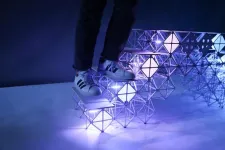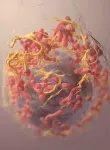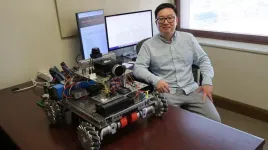(Press-News.org) CLEVELAND—Brain implants hold immense promise for restoring function in patients with paralysis, epilepsy and other neurological disorders.
But a team of researchers at Case Western Reserve University has discovered that bacteria can invade the brain after a medical device is implanted, contributing to inflammation and reducing the device’s long-term effectiveness.
The groundbreaking research, recently published in Nature Communications, could improve the long-term success of brain implants now that a target has been identified to address.
“Understanding the role of bacteria in implant performance and brain health could revolutionize how these devices are designed and maintained,” said Jeff Capadona, Case Western Reserve’s vice provost for innovation, the Donnell Institute Professor of Biomedical Engineering and senior research career scientist at the Louis Stokes Cleveland VA Medical Center.
Capadona’s lab led the study, which examined the presence of bacterial DNA in the brains of mouse models implanted with microelectrodes.
To their surprise, researchers found bacteria linked to the gut inside the brain. The discovery suggests that a breach in what is known as “the blood-brain barrier,” caused by implanting the device, could allow microbes to enter.
“This is a paradigm-shifting finding,” said George Hoeferlin, the study’s lead author, who was a biomedical engineering graduate student at Case Western Reserve in Capadona’s lab. “For decades, the field has focused on the body's immune response to these implants, but our research now shows that bacteria—some originating from the gut—are also playing a role in the inflammation surrounding these devices.”
In the study, mouse models treated with antibiotics had reduced bacterial contamination and the performance of the implanted devices improved—although prolonged antibiotic use proved detrimental.
The discovery’s implications go beyond device failure. Some of the bacteria found in the brain have been linked to neurological diseases, including Alzheimer's, Parkinson’s and stroke.
“If we’re not identifying or addressing this consequence of implantation, we could be causing more harm than we’re fixing,” Capadona said. “This finding highlights the urgent need to develop a permanent strategy for preventing bacterial invasion from implanted devices, rather than just managing inflammation after the fact. The more we understand about this process, the better we can design implants that work safely and effectively.”
Capadona said his lab is now expanding the research to examine bacteria in other types of brain implants, such as ventricular shunts used to treat hydrocephalus, an abnormal buildup of fluid in the brain.
The team also examined the fecal matter of a human subject implanted with a brain device and found similar results.
“This finding stresses the importance of understanding how bacterial invasion may not just be a laboratory phenomenon, but a clinically relevant issue,” said Bolu Ajiboye, the Robert and Brenda Aiken Professor in biomedical engineering at the Case School of Engineering and School of Medicine and scientist at the Cleveland VA Medical Center. “Through our strong translational pipeline between CWRU and the VA, we are now investigating how this discovery can directly contribute to safer, more effective neural implant strategies for patients.”
The research was supported by the U.S. Department of Veterans Affairs’ Advanced Platform Technology Center, National Institutes of Health, Department of Defense and the Donnell Institute Professorship Endowment.
###
At Case Western Reserve, one of the nation's leading research universities, we're driven to seek knowledge and find solutions to some of the world's most pressing problems. Nearly 6,200 undergraduate and 6,100 graduate students from across 96 countries study in our more than 250 degree programs across arts, dental medicine, engineering, law, management, medicine, nursing, science and social work. Our location in Cleveland, Ohio—a hub of cultural, business and healthcare activity—gives students unparalleled access to engaging academic, research, clinical, entrepreneurial and volunteer opportunities and prepares them to join our network of 125,000+ alumni making an impact worldwide. Visit case.edu to learn more.
END
Bacteria invade brain after implanting medical devices
New research could transform design of brain implants for neurological disorders to make them safer, more effective
2025-03-18
ELSE PRESS RELEASES FROM THIS DATE:
New platform lets anyone rapidly prototype large, sturdy interactive structures
2025-03-18
CAMBRIDGE, MA – Prototyping large structures with integrated electronics, like a chair that can monitor someone’s sitting posture, is typically a laborious and wasteful process.
One might need to fabricate multiple versions of the chair structure via 3D printing and laser cutting, generating a great deal of waste, before assembling the frame, grafting sensors and other fragile electronics onto it, and then wiring it up to create a working device.
If the prototype fails, the maker will likely have no choice but to discard it and go back to the drawing board.
MIT researchers have come up with a better way to iteratively design large and sturdy ...
Non-genetic theories of cancer address inconsistencies in current paradigm
2025-03-18
It’s time for researchers to reconsider the current paradigm of cancer as a genetic disease, argued Sui Huang from the Institute for Systems Biology, USA, and colleagues in a new essay published March 18th in the open-access journal PLOS Biology.
The prevailing theory on the origin of cancer is that an otherwise normal cell accumulates genetic mutations that allow it to grow and reproduce unchecked. This paradigm has driven large-scale cancer genome sequencing projects, such as The Cancer Genome Atlas, to identify cancer-driving mutations ...
Food and non-alcoholic drink products in Mexico were substantially reformulated to be healthier following the 2020 introduction of warning labels identifying products with excessive content of calorie
2025-03-18
Food and non-alcoholic drink products in Mexico were substantially reformulated to be healthier following the 2020 introduction of warning labels identifying products with excessive content of calories, fat, salt, sugar, sweetener and caffeine
In your coverage, please use this URL to provide access to the freely available paper in PLOS Medicine: http://journals.plos.org/plosmedicine/article?id=10.1371/journal.pmed.1004533
Article title: Product reformulation in non-alcoholic beverages and foods after the implementation ...
Conservation efforts are bringing species back from the brink, even as overall biodiversity falls
2025-03-18
A major review of over 67,000 animal species has found that while the natural world continues to face a biodiversity crisis, targeted conservation efforts are helping bring many species back from the brink of extinction.
The study draws on data from the IUCN Red List, the world’s largest database of species conservation status. The researchers say their results, reported in the journal PLOS Biology, highlight both the successes and the need for urgent action.
The world is facing a global biodiversity crisis, with 28% of more than 160,000 assessed species threatened with extinction, and an estimated one million species facing this fate due to human activities. ...
Conservation efforts analysis reveals which actions are most helpful for endangered species status
2025-03-18
Targeted conservation actions are essential to prevent wildlife extinctions, but more efforts are needed to fully recover biodiversity, according to a study published March 18th in the open-access journal PLOS Biology by Ashley Simkins of the University of Cambridge, UK and colleagues.
Out of over 166,000 species assessed by the International Union for Conservation of Nature, around 28% are threatened with extinction. Global efforts to prevent extinction and recover biodiversity have had some success, but there is limited data to show which conservation actions are most effective. In this study, Simkins and colleagues compile information ...
JSCAI special issue explores the transformative role of artificial intelligence in interventional cardiology
2025-03-18
WASHINGTON —The Journal of the Society for Cardiovascular Angiography & Interventions (JSCAI) proudly announces the publication of a groundbreaking special issue: The Role of Artificial Intelligence in Cardiovascular Interventions.
This issue explores how artificial intelligence (AI) is revolutionizing interventional cardiology, from diagnostic precision to procedural planning and patient outcomes. It features a collection of original research, reviews, and viewpoints that delve into AI’s applications across ...
Wayne State University research making strides in autonomous vehicle and machine systems to make them safer, more effective
2025-03-18
DETROIT — A grant to Wayne State University from the National Science Foundation (NSF) is opening new doors for researchers and students to explore the future of autonomous vehicles, machines and drones.
Zheng Dong, Ph.D., assistant professor of computer science in Wayne State’s School of Engineering, was awarded a five-year, $595,611 NSF grant for the project, "CAREER: ChronosDrive: Ensuring Timing Correctness in DNN-Driven Autonomous Vehicles with Accelerator-Enhanced Real-Time SoC Integration."
“We ...
Thorny skates come in snack and party sizes. After a century of guessing, scientists now know why.
2025-03-18
When Jeff Kneebone was a college student in 2002, his research involved a marine mystery that has stumped curious scientists for the last two decades. That mystery had to do with thorny skates in the North Atlantic. In some parts of their range, individuals of this species come in two distinct sizes, irrespective of sex, and no one could figure out why. At the time, neither could Kneebone.
In a new study, Kneebone and researchers from the Florida Museum of Natural History say they’ve finally found an answer. And it’s all thanks to COVID-19.
People have known about the size discrepancy in thorny skates for nearly a century, but it became critically ...
When did human language emerge?
2025-03-18
It is a deep question, from deep in our history: When did human language as we know it emerge? A new survey of genomic evidence suggests our unique language capacity was present at least 135,000 years ago. Subsequently, language might have entered social use 100,000 years ago.
Our species, Homo sapiens, is about 230,000 years old. Estimates of when language originated vary widely, based on different forms of evidence, from fossils to cultural artifacts. The authors of the new analysis took a different approach. ...
Meteorites: A geologic map of the asteroid belt
2025-03-18
March 18, 2025, Mountain View, CA -- Where do meteorites of different type come from? In a review paper in the journal Meteoritics & Planetary Science, published online this week, astronomers trace the impact orbit of observed meteorite falls to several previously unidentified source regions in the asteroid belt.
“This has been a decade-long detective story, with each recorded meteorite fall providing a new clue,” said meteor astronomer and lead author Peter Jenniskens of the SETI Institute and NASA Ames Research Center. “We now have the first outlines of a geologic map of the asteroid belt.”
Ten years ago, ...
LAST 30 PRESS RELEASES:
UVA’s Jundong Li wins ICDM’S 2025 Tao Li Award for data mining, machine learning
UVA’s low-power, high-performance computer power player Mircea Stan earns National Academy of Inventors fellowship
Not playing by the rules: USU researcher explores filamentous algae dynamics in rivers
Do our body clocks influence our risk of dementia?
Anthropologists offer new evidence of bipedalism in long-debated fossil discovery
Safer receipt paper from wood
Dosage-sensitive genes suggest no whole-genome duplications in ancestral angiosperm
First ancient human herpesvirus genomes document their deep history with humans
Why Some Bacteria Survive Antibiotics and How to Stop Them - New study reveals that bacteria can survive antibiotic treatment through two fundamentally different “shutdown modes”
UCLA study links scar healing to dangerous placenta condition
CHANGE-seq-BE finds off-target changes in the genome from base editors
The Journal of Nuclear Medicine Ahead-of-Print Tip Sheet: January 2, 2026
Delayed or absent first dose of measles, mumps, and rubella vaccination
Trends in US preterm birth rates by household income and race and ethnicity
Study identifies potential biomarker linked to progression and brain inflammation in multiple sclerosis
Many mothers in Norway do not show up for postnatal check-ups
Researchers want to find out why quick clay is so unstable
Superradiant spins show teamwork at the quantum scale
Cleveland Clinic Research links tumor bacteria to immunotherapy resistance in head and neck cancer
First Editorial of 2026: Resisting AI slop
Joint ground- and space-based observations reveal Saturn-mass rogue planet
Inheritable genetic variant offers protection against blood cancer risk and progression
Pigs settled Pacific islands alongside early human voyagers
A Coral reef’s daily pulse reshapes microbes in surrounding waters
EAST Tokamak experiments exceed plasma density limit, offering new approach to fusion ignition
Groundbreaking discovery reveals Africa’s oldest cremation pyre and complex ritual practices
First breathing ‘lung-on-chip’ developed using genetically identical cells
How people moved pigs across the Pacific
Interaction of climate change and human activity and its impact on plant diversity in Qinghai-Tibet plateau
From addressing uncertainty to national strategy: an interpretation of Professor Lim Siong Guan’s views
[Press-News.org] Bacteria invade brain after implanting medical devicesNew research could transform design of brain implants for neurological disorders to make them safer, more effective










